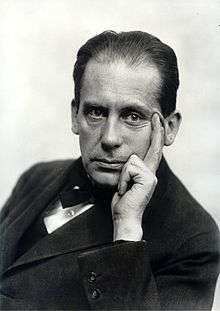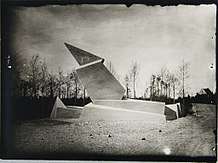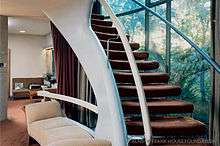Walter Gropius
Walter Adolph Georg Gropius (18 May 1883 – 5 July 1969) was a German architect and founder of the Bauhaus School,[1] who, along with Alvar Aalto, Ludwig Mies van der Rohe, Le Corbusier and Frank Lloyd Wright, is widely regarded as one of the pioneering masters of modernist architecture. He is a founder of Bauhaus in Weimar (1919).[2] Gropius was also a leading architect of the International Style.[3]
Walter Gropius | |
|---|---|
 Walter Gropius (circa 1919). Photo by Louis Held | |
| Born | Walter Adolph Georg Gropius 18 May 1883 |
| Died | 5 July 1969 (aged 86) Boston, Massachusetts, U.S. |
| Occupation | Architect |
| Spouse(s) | Alma Mahler (m. 1915; div. 1920) Ise Gropius (m. 1923) |
| Children | 2, including Manon Gropius |
| Awards |
|
| Practice |
|
| Buildings | |
Family and early life
Born in Berlin, Walter Gropius was the third child of Walter Adolph Gropius and Manon Auguste Pauline Scharnweber (1855–1933), daughter of the Prussian politician Georg Scharnweber (1816-1894). Walter's uncle Martin Gropius (1824-1880) was the architect of the Kunstgewerbemuseum in Berlin and a follower of Karl Friedrich Schinkel, with whom Walter's great-grandfather Carl Gropius, who fought under Field Marshal Gebhard Leberecht von Blücher at the Battle of Waterloo, had shared a flat as a bachelor.[4]
.png)



In 1915 Gropius married Alma Mahler (1879–1964), widow of Gustav Mahler. Walter and Alma's daughter, named Manon after Walter's mother, was born in 1916. When Manon died of polio at age 18, in 1935, composer Alban Berg wrote his Violin Concerto in memory of her (it is inscribed "to the memory of an angel"). Gropius and Mahler divorced in 1920. (She had by that time established a relationship with Franz Werfel, whom she later married.)
On 16 October 1923, Gropius married Ilse (later Ise) Frank; they remained together until his death in 1969. Ise Frank was Jewish.[5] The couple adopted a daughter together, Beate Gropius, known as Ati.[6] Ise Gropius died on 9 June 1983 in Lexington, Massachusetts.[7]
Walter's only sister Manon Burchard (1880-1975) is the great-grandmother of the German film and theater actresses Marie Burchard and Bettina Burchard, and of the curator and art historian Wolf Burchard.[8]
Career
Early career (1908–14)
Gropius could not draw, and was dependent on collaborators and partner-interpreters throughout his career. In school he hired an assistant to complete his homework for him. In 1908, after studying architecture in Munich and Berlin for four semesters, Gropius joined the office of the renowned architect and industrial designer Peter Behrens, one of the first members of the utilitarian school.[7] His fellow employees at this time included Ludwig Mies van der Rohe, Le Corbusier, and Dietrich Marcks.
In 1910 Gropius left the firm of Behrens and together with fellow employee Adolf Meyer established a practice in Berlin. Together they share credit for one of the pioneering modernist buildings created during this period: the Faguswerk in Alfeld-an-der-Leine, Germany, a shoe last factory. Although Gropius and Meyer only designed the facade, the glass curtain walls of this building demonstrated both the modernist principle that form reflects function and Gropius's concern with providing healthful conditions for the working class. The factory is now regarded as one of the crucial founding monuments of European modernism. Gropius was commissioned in 1913 to design a car for the Prussian Railroad Locomotive Works in Königsberg. This locomotive was unique and the first of its kind in Germany and perhaps in Europe.[9] Other works of this early period include the office and factory building for the Werkbund Exhibition (1914) in Cologne.
In 1913, Gropius published an article about "The Development of Industrial Buildings," which included about a dozen photographs of factories and grain elevators in North America. A very influential text, this article had a strong influence on other European modernists, including Le Corbusier and Erich Mendelsohn, both of whom reprinted Gropius's grain elevator pictures between 1920 and 1930.[10]
Gropius's career was interrupted by the outbreak of World War I in 1914. He was drafted August 1914 and served as a sergeant major at the Western front during the war years (getting wounded and almost killed)[11] and then as a lieutenant in the signal corps.[12] Gropius was awarded the Iron Cross twice[13] ("when it still meant something," he confided to his friend Chester Nagel) after fighting for four years.[14] Gropius then, like his father and his great-uncle Martin Gropius before him, became an architect.
Bauhaus period (1919–32)
Gropius's career advanced in the postwar period. Henry van de Velde, the master of the Grand-Ducal Saxon School of Arts and Crafts in Weimar was asked to step down in 1915 due to his Belgian nationality. His recommendation for Gropius to succeed him led eventually to Gropius's appointment as master of the school in 1919. It was this academy which Gropius transformed into the world-famous Bauhaus, attracting a faculty that included Paul Klee, Johannes Itten, Josef Albers, Herbert Bayer, László Moholy-Nagy, Otto Bartning and Wassily Kandinsky. In principle, the Bauhaus represented an opportunity to extend beauty and quality to every home through well designed industrially produced objects. The Bauhaus program was experimental and the emphasis was theoretical.[15] One example product of the Bauhaus was the armchair F 51, designed for the Bauhaus's directors room in 1920 – nowadays a re-edition in the market, manufactured by the German company TECTA/Lauenfoerde.
In 1919, Gropius was involved in the Glass Chain utopian expressionist correspondence under the pseudonym "Mass." Usually more notable for his functionalist approach, the Monument to the March Dead, designed in 1919 and executed in 1920, indicates that expressionism was an influence on him at that time.
In 1923, Gropius designed his famous door handles, now considered an icon of 20th-century design and often listed as one of the most influential designs to emerge from Bauhaus. Gropius designed the new Bauhaus Dessau school building in 1925-26 on commission from the city of Dessau. He collaborated with Carl Fieger, Ernst Neufert and others within his private architectural practice.[16] He also designed large-scale housing projects in Berlin, Karlsruhe and Dessau in 1926–32 that were major contributions to the New Objectivity movement, including a contribution to the Siemensstadt project in Berlin.
Gropius left the Bauhaus in 1928 and moved to Berlin. Hannes Meyer took over the role of Bauhaus director.[17] His work was also part of the architecture event in the art competition at the 1932 Summer Olympics.[18]
Post-Bauhaus (1933–45)
The rise of Hitler in the 1930s would soon drive Gropius out of Germany. Before that, however, he did accept an invitation in early 1933 to compete for the design of the new Reichsbank building and submitted a detailed plan.[19]
With the help of the English architect Maxwell Fry, Gropius was able to leave Nazi Germany in 1934, on the pretext of making a temporary visit to Italy for a film propaganda festival; he then fled to Britain to avoid the fascist powers of Europe. He lived and worked in the artists' community associated with Herbert Read in Hampstead, London, as part of the Isokon group with Fry and others for three years, before moving on to the United States with his family.[20] Gropius and his second wife, Ise Gropius, arrived in the United States in February 1937, while their twelve-year-old daughter, Ati, finished the school year in England.[21] Though built in 1938, the Gropiuses believed their house could embody architectural qualities similar to those practiced today, such as simplicity, economy, and aesthetic beauty.[21] In designing his house, Gropius used the approach developed at the Bauhaus. The house the Gropiuses built for themselves in Lincoln, Massachusetts (now known as Gropius House), was influential in bringing International Modernism to the U.S., but Gropius disliked the term: "I made it a point to absorb into my own conception those features of the New England architectural tradition that I found still alive and adequate."[22] Helen Storrow, a banker's wife and philanthropist, became Gropius's benefactor when she invested a portion of her land and wealth for the architect's home. She was so satisfied with the result that she gave more land and financial support to four other professors, two of whom Gropius designed homes for. With the Bauhaus philosophy in mind, every aspect of the homes and their surrounding landscapes was planned for maximum efficiency and simplicity. Gropius's house received a huge response and was declared a National Landmark in 2000.[23]
Gropius and his Bauhaus protégé Marcel Breuer both moved to Cambridge, Massachusetts, to teach at the Harvard Graduate School of Design (1937–1952)[24] and collaborate on projects including The Alan I W Frank House in Pittsburgh and the company-town Aluminum City Terrace project in New Kensington, Pennsylvania, before their professional split. In 1938 he was appointed Chair of the Department of Architecture, a post he held until his retirement in 1952.[25] Gropius also sat on the Massachusetts Institute of Technology (MIT) Visiting Committee at the end of his career. The well-known architect designed the Richards and Child residence halls on the Harvard campus that were built in the 1950s.[26] In 1944, he became a naturalized citizen of the United States.
In 1946, Gropius founded the young architects' association, The Architects' Collaborative (TAC), a manifestation of his lifelong belief in the significance of teamwork, which he had already successfully introduced at the Bauhaus. Based in Cambridge with a group of younger architects, which the original partners included Norman C. Fletcher, Jean B. Fletcher, John C. Harkness, Sarah P. Harkness, Robert S. MacMillan, Louis A. MacMillen, and Benjamin C. Thompson. One work produced by this office is the Graduate Center of Harvard University in Cambridge (1949/50).[27] TAC would become one of the most well-known and respected architectural firms in the world. TAC went bankrupt in 1995.
In 1967, Gropius was elected into the National Academy of Design as an Associate member and became a full Academician in 1968.
Death
Gropius died on July 5, 1969, in Boston, Massachusetts, aged 86. He had been diagnosed with inflammation of the glands, and was admitted to hospital on 7 June. After an operation was performed successfully on 15 June, there was hope of a full recovery. Gropius described himself as a "tough old bird", and continued to make progress for about a week. However, his lungs became congested and could not supply proper amounts of oxygen to the blood and brain. He lost consciousness, and died in his sleep.[28]
Legacy
Today, Gropius is remembered not only by his various buildings but also by the district of Gropiusstadt in Berlin. In the early 1990s, a series of books entitled The Walter Gropius Archive was published covering his entire architectural career. The CD audiobook Bauhaus Reviewed 1919–33 includes a lengthy English Language interview with Gropius.
Upon his death his widow, Ise Gropius, arranged to have his collection of papers divided into early and late papers. Both parts were photographed with funds provided by the Thyssen Foundation. The late papers, relating to Gropius's career after 1937, and the photos of the early ones, then went to the Houghton Library at Harvard University; the early papers and photos of the late papers went to the Bauhaus Archiv, then in Darmstadt, since reestablished in Berlin.[29] Mrs. Gropius also deeded the Gropius House in Lincoln to Historic New England in 1980. The Gropius house was added to the National Register of Historic Places in 1988 and is now available to the public for tours.[23]
Bauhaus Center Tel Aviv in the White City recognizes the greatest concentration of Bauhaus buildings in the world.
In 1959 he received the AIA Gold Medal. On May 17, 2008, Google Doodle commemorated Walter Gropius' 125th birthday.[30]
Selected buildings
- 1910–11 the Fagus Factory, Alfeld an der Leine, Germany
- 1914 Office and Factory Buildings at the Werkbund Exhibition, 1914, Cologne, Germany
- 1921 Sommerfeld House, Berlin, Germany designed for Adolf Sommerfeld
- 1922 competition entry for the Chicago Tribune Tower competition
- 1925–32 Bauhaus School and Meisterhäuser (houses for senior staff), Dessau, Germany
- 1926-28 Törten housing estate in Dessau.[31]
- 1936 Village College, Impington, Cambridge, England
- 1936 66 Old Church Street, Chelsea, London, England
- 1937 The Gropius House, Lincoln, Massachusetts, USA
- 1939 Waldenmark, Wrightstown Township, Pennsylvania (with Marcel Breuer)
- 1939-40 The Alan I W Frank House, Pittsburgh, Pennsylvania (with Marcel Breuer)
- 1942–44 Aluminum City Terrace housing project, New Kensington, Pennsylvania, USA
- 1945–59 Michael Reese Hospital, Chicago, Illinois, USA – Master planned 37-acre (150,000 m2) site and led the design for at least 8 of the approx. 28 buildings.[32]
- 1949–50 Harvard Graduate Center, Cambridge, Massachusetts, USA (The Architects' Collaborative)[33]
- 1957–60 University of Baghdad, Baghdad, Iraq
- 1963–66 John F. Kennedy Federal Office Building, Boston, Massachusetts, USA
- 1948 Peter Thacher Junior High School,
- 1957–59 Dr. and Mrs. Carl Murchison House, Provincetown, Massachusetts, USA (The Architects' Collaborative)
- 1958–63 Pan Am Building (now the Metlife Building), New York, with Pietro Belluschi and project architects Emery Roth & Sons
- 1957 Interbau Apartment blocks, Hansaviertel (Walter-Gropius-Haus) Berlin, Germany, with The Architects' Collaborative and Wils Ebert
- 1960 Temple Oheb Shalom (Baltimore, Maryland)
- 1960 the Gropiusstadt building complex, Berlin, Germany
- 1961 The award-winning Wayland High School, Wayland, Massachusetts, USA (demolished 2012)
- 1959–61 Embassy of the United States, Athens, Greece (The Architects' Collaborative and consulting architect Pericles A. Sakellarios)
- 1968 Glass Cathedral, Thomas Glassworks, Amberg
- 1967–69 Tower East, Shaker Heights, Ohio, was Gropius's last major project.
- 1968-70 Huntington Museum of Art, Huntington, West Virginia, USA. Original building expanded with Gropius addition with little alteration to the original structure. Only American art museum to be brought to completion using a Gropius design.
- 1973–80 Porto Carras, at Chalkidiki, Greece, was built posthumously from Gropius designs, it is one of the largest holiday resorts in Europe.
NB: The building in Niederkirchnerstraße, Berlin known as the Gropius-Bau is named for Gropius's great-uncle, Martin Gropius, and is not associated with the Bauhaus.
Gallery
- Bauhaus Dessau building, built 1925–26
 Gropius House (1938) in Lincoln, Massachusetts
Gropius House (1938) in Lincoln, Massachusetts The Alan I W Frank House
The Alan I W Frank House Aluminum City Terrace (1944)
Aluminum City Terrace (1944)
References
- Bauhaus, The Tate Collection, retrieved 18 May 2008
- Caves, R. W. (2004). Encyclopedia of the City. Routledge. p. 319.
- "International Style | architecture". Encyclopedia Britannica. Retrieved 17 September 2018.
- Wolf Burchard,'"Onkel Walter": Family Memories of Walter Gropius', The Decorative Arts Society Newsletter 104 (Summer 2015): 5
- "A New Biography Paints a Colorful Portrait of Bauhaus Founder Walter Gropius". Hyperallergic. 19 March 2019. Retrieved 8 November 2019.
- "Recollections by Ati Gropius Johansen, daughter of Walter and Ise Gropius" Archived 5 May 2014 at the Wayback Machine, ArchitectureBoston, Summer 2013 issue: American Gropius (Volume 16 n2)
- "Ise Gropius (-Frank)" Archived 8 April 2014 at the Wayback Machine. bauhaus-online.de.
- Deutsches Geschlechterbuch, volume 3, 1972
- Isaacs, pp. 25 and 29
- American Colossus: the Grain Elevator 1843–1943 Archived 2 November 2009 at the Wayback Machine, Colossus Books, 2009. american-colossus.com
- "Walter Adolph Gropius 1883 – 1969". British Broadcasting Corporation. Archived from the original on 4 November 2006. Retrieved 2 August 2006.
- Isaacs, pp. 38–41
- Paul Davies (30 April 2013) "Walter Gropius". architectural-review.com.
- "Ties to the past". news.harvard.edu (19 March 2014)
- Isaacs, pp. 66–72
- Bauhaus Dessau Foundation. The Bauhaus Building by Walter Gropius Archived 28 December 2018 at the Wayback Machine. Retrieved 3 January 2019
- Bauhaus100. Walter Gropius Archived 7 February 2017 at the Wayback Machine Retrieved 6 February 2017
- "Walter Gropius". Olympedia. Retrieved 30 July 2020.
- "Strange Bedfellows: The Modernists and the Nazis - Los Angeles Review of Books". lareviewofbooks.org. Retrieved 27 March 2018.
- Lawrence Gowing, ed., Biographical Encyclopedia of Artists, v.2 (Facts on File, 2005): 287.
- Gropius House History. Historic New England
- Gropius House by Walter Gropius. galinsky.com
- "Walter Gropius". ncmodernist.org
- Gropius, Walter, 1883-1969. Papers, 1930-1972: A Guide, Harvard University, archived from the original on 3 January 2017, retrieved 13 January 2017
- "Walter Gropius". Encyclopædia Britannica.
- "GSAS Residence Halls" Archived 27 April 2014 at the Wayback Machine. gsas.harvard.edu.
- "Walter Gropius" Archived 1 April 2014 at the Wayback Machine. bauhaus-online.de.
- Isaacs, p. 311
- "Gropius, Walter, 1883–1969. Additional papers". Houghton Library, Harvard University, Online Finding Aid. Retrieved 4 June 2012.
- "125th Birthday of Walter Gropius". Google. 17 May 2008.
- "Das Bauhaus in Dessau". www.bauhaus-dessau.de (in German). Retrieved 19 May 2019.
- Mertens, Richard (20 August 2009). "Battle to Save Chicago's Gropius Architecture has Preservationists and City at Odds". Christian Science Monitor: 17 – via ProQuest.
- Harvard Graduate Center – Walter Gropius – Great Buildings Online. greatbuildings.com
Bibliography
- Isaacs, Reginald (1991). Walter Gropius: An illustrated Biography of the Creator of the Bauhaus (First English-language ed.). Berlin: Bulfinch Press. ISBN 978-0-8212-1753-5.
Further reading
| Library resources about Walter Gropius |
| By Walter Gropius |
|---|
- The New Architecture and the Bauhaus, Walter Gropius, 1935.
- The Scope of Total Architecture, Walter Gropius, 1956.
- From Bauhaus to Our House, Tom Wolfe, 1981.
- The Walter Gropius Archive, Routledge (publisher), 1990–1991.
External links
| Wikiquote has quotations related to: Walter Gropius |
| Wikimedia Commons has media related to Walter Gropius. |
- Designer portrait on rosenthalusa.com
- More information on Gropius's early years at the Bauhaus can be found in his correspondence with Lily Hildebrandt, with whom he had an affair between 1919–22: Getty Research Institute, California.
- Bauhaus Reviewed 1919–33 audiobook liner notes at LTM
- Newspaper clippings about Walter Gropius in the 20th Century Press Archives of the ZBW